Did you know that the world’s oldest hotel is in Japan? “Keiunkan, Koshu Nishiyama Hot Spring” which is located in the town of Hayakawa in Yamanashi prefecture, Japan is certified as “the world’s most historical inn” by the Guinness Book of World Records in 2011.
The history of Keiunkan Inn dates back 1300 years. The hot spring was founded by a scholar named Fujiwara no Mahito in AD 705 which was the 2nd year of the Keiun Era during the reign of Emperor Monmu. Mahito was the son of Fujiwara no Kamatari who served as a politician under Emperor Tenchi. It has also been recorded that famous Samurais such as Takeda Shingen and Tokugawa Ieyasu have stayed here for recuperation during the feudal time.
Keiunkan has been passed down through the same family lineage for 52 generations. Yuji Fukazawa is the current president of Keiunkan. Although the Inn is located in a remote mountain area, it runs a successful business. According to the customer survey conducted by Japan Travel Bureau, Keiunkan has received 95% satisfaction rate.

Fukazawa has shared the secret of his Inn’s success with the readers of a Japanese business Journal, ITmedia Business. He keeps the hot spring water to be pure and as natural as possible. No chloride, no additives, no tap water is added. He also does not use any artificial heating processes. In 2004, many hot spring resorts in Japan were found to be using recycled water or artificially blended tap water. However, Keiunkan intentionally kept its tradition of offering natural hot spring water. Because of Fukazawa’s efforts, Keiunkan still offers the the pure hot spring similar to what people enjoyed 1300 years ago.



